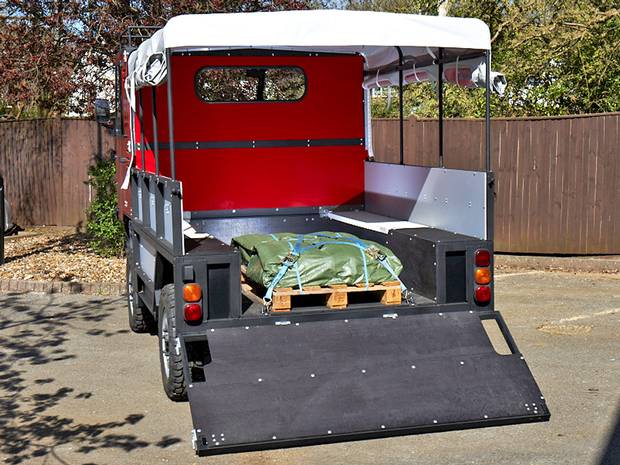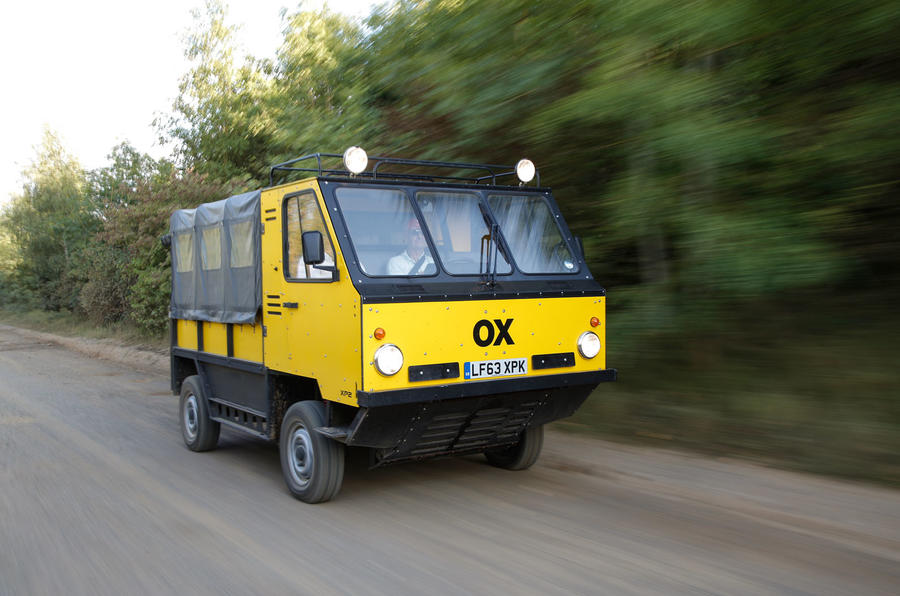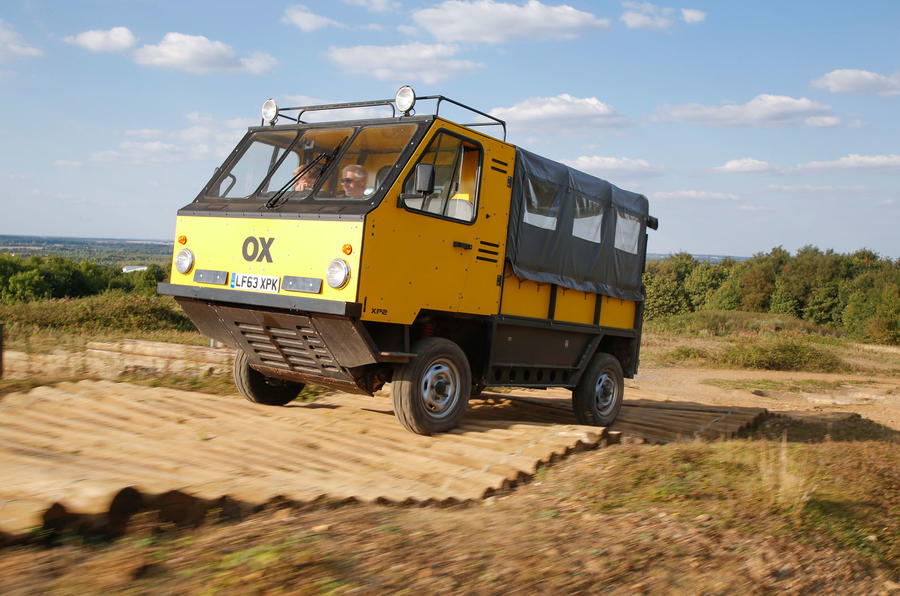- The first vehicle to be designed specifically to provide all-terrain mobility for the developing world
- Revolutionary OX™ flat-pack truck aims to help communities to undertake a range of crucial daily tasks
- Envisioned by entrepreneur and philanthropist Sir Torquil Norman; designed by renowned automotive engineer Professor Gordon Murray
The world’s first ‘flat-pack’ truck – the Global Vehicle Trust OX – has been revealed in London, designed to provide low-cost all-terrain mobility for remote parts of Africa and the developing world.
Across Africa and other developing world, there is intense need for improved transport, for both everyday living as well as emergencies.
The OX has been designed specifically to tackle a host of transport challenges, and to undertake crucial daily tasks, such as collect drinking water and transporting grain, fertilizer or building materials. It is unlike any other vehicle and has no direct competitor – whether from a concept, performance or pricing point of view.
The OX originated from the vision of one man – Sir Torquil Norman. Five years ago, he founded the Global Vehicle Trust (GVT), to pursue his ambition to help people in the developing world by providing cost-effective mobility. The GVT subsequently briefed renowned automotive designer Professor Gordon Murray on a unique humanitarian programme to create a revolutionary lightweight truck.
The brief for the vehicle called for high ground clearance, excellent approach and departure angles, large wheel movement, a multi-purpose layout and a three-person cab. Gordon Murray’s design for the OX is nothing short of revolutionary, and the flat-pack format fundamentally changes the way a vehicle can be bought and transported, providing specific advantages to lead times and overall unit cost.
The OX has been designed to offer superb all-terrain ability, but it also has a huge and adaptable load carrying capability. The packaging is a key triumph of the OX project: the overall vehicle length is far shorter than a large SUV, and yet it can carry a payload of 1900kg (approximately twice the capacity of most current pick-ups) with a load volume of 7.0 m3. Based on EU size guidelines, it can seat up to 13 people or carry eight 44-gallon drums or three Euro-pallets.
Therefore, the OX not only addresses the problems with the roads; it also addresses the specific need to transport large volumes of goods and people at low cost.
The OX’s cabin provides spacious accommodation for three people, and the driver is seated centrally. This layout has specific advantages for the world’s developing countries, some of which have right-hand traffic, while others drive on the left of the road.
All-terrain ability is crucial for the developing world, and the OX has been engineered to perform as well as, or better than, a four-wheel drive vehicle across a range of surfaces, while offering durable mobility with two driven wheels.
The OX’s revolutionary nature extends beyond the vehicle design because, uniquely, it is capable of being flat-packed within itself, enabling it to be transported more efficiently around the world. It takes three people less than six hours to create the flat pack in the UK prior to shipping, and six of these flat packs can be shipped within a 40ft high-cube container. Assembly labour is transferred to the importing country, where local professional companies will be employed to assemble and maintain the finished vehicles. Three skilled people can put an OX together in approximately 12 hours.
Beyond its revolutionary packaging design and two-wheel-drive all-terrain ability, the OX is full of design innovations. For example, the tailgate does not merely contain the load in the back; it detaches completely from the OX and can be rotated lengthways to double as a loading ramp. The rear bench seat bases also have a dual purpose. The long ‘egg crate’ frames can be removed from the vehicle and used as ‘sand ladders’ under the wheels to help the OX traverse challenging soft ground.
Sir Torquil Norman said: “My inspiration for the OX goes back to seeing the ‘Africar’ project of the 1980s. This project shares some of the aims of that vehicle, but its execution is radically different. OX was just a dream six years ago, but it is now a realistic prospect for production with working prototypes that have completed a comprehensive testing programme.”
Professor Gordon Murray said: “The OX design and prototyping programme is undoubtedly one of the most interesting and challenging I have undertaken during my 45 years of car design, including my years in F1.
“The added challenge of a flat-packed vehicle design over the already tough targets for cost, durability and weight saving made for a fascinating and stimulating journey from concept to prototype.
“The most satisfying elements of the project for me are that the OX will make such a difference to so many people and that it has no competitor in any part of the world. It has been a privilege to work alongside Torquil to make his vision a reality.”
Driving the next stage of development
The global launch of the OX aims to highlight the need for investment and support in order to progress the project to completion. The Global Vehicle Trust believes that the OX project will attract a wide range of interest from potential backers.
Sir Torquil Norman said: “Feedback we have had so far from contacts in Africa and with aid agencies has been very positive. OX is about making a difference now, being part of something ground-breaking and unique. Most of all it presents a real opportunity to make a fundamental and lasting difference to people’s lives.
“Our priority now is to raise the funding to complete the testing and take the project to fruition. We believe that the OX has huge potential for charities, aid organisations and development programmes. My dream is to one day see an OX in every village in Africa.”
Technical specifications – XP3 prototype
Dimensions (mm)
| Exterior | (mm) |
| Overall length | 4,229 |
| Overall width | 2,070 |
| Overall height | 2,302 |
| Wheelbase | 2,560 |
| Track | 1,795 |
Weights (kg)
| Dry weight | 1600 kg |
| Payload capacity | 1900 kg |
Suspension and damping
| Front | OXGlide™ leading arms, telescopic dampers and coil springs |
| Rear | OXGlide™ trailing arms, telescopic dampers and coil springs |
Engine
| 2.2-litre 16v Diesel | |
| Type | 4 valves per cylinder |
| Capacity (cc) | 2198 |
| Bore x stroke (mm) | 86.0 x 94.6 |
| Compression ratio | 17.5:1 |
| Power | 100 PS at 3,500 rpm |
| Torque | 310 Nm at 2,100 rpm |
Transmission
| Manual, All Synchromesh | 5 speed + reverse |
Steering
| Type | Rack and pinion |
| Turning circle | 11.7m |
Brakes
| Front | 300 mm ventilated disc |
| Rear | 280 mm solid disc |
Wheels and tyres
| Wheel size | Tyres - Front | Tyres - Rear |
| x 16-inch | 205/80 R16 | 205/80 R16 |
Capacities (litres)
| Luggage | 3,430 (to sides) / 7,000 (maximum) |
| Fuel tank | 80 |









No comments:
Post a Comment
Please leave a message, I will verify them swiftly, Sorry to have to do this now as some twat keeps spamming my message system, unfortunately they are ignorant and spoil it for everyone else,
Note: only a member of this blog may post a comment.